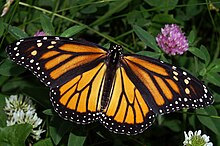
Back Flächenbelastung (Flügel) German Flugilŝarĝo Esperanto Carga alar Spanish بارگیری بال Persian Charge alaire French עומס כנף HE Specifično opterećenje krila Croatian Beban sayap ID Carico alare Italian 翼面荷重 Japanese


In aerodynamics, wing loading is the total weight of an aircraft or flying animal divided by the area of its wing.[1][a] The stalling speed, takeoff speed and landing speed of an aircraft are partly determined by its wing loading.[2]
The faster an aircraft flies, the more its lift is changed by a change in angle of attack so a smaller wing is less adversely affected by vertical gusts. Consequently, faster aircraft generally have higher wing loadings than slower aircraft in order to avoid excessive response to vertical gusts.[3]
A higher wing loading also decreases maneuverability. The same constraints apply to winged biological organisms.
- ^ "Wing Loading Definition". Merriam Webster.
- ^ a b "Chapter 11: Aircraft Performance". Pilot's Handbook of Aeronautical Knowledge (FAA-H-8083-25C ed.). Federal Aviation Administration. 17 July 2023. pp. 8–9.
- ^ Wragg, David W. (1973). A Dictionary of Aviation (first ed.). Osprey. p. 281. ISBN 9780850451634.
Cite error: There are <ref group=lower-alpha> tags or {{efn}} templates on this page, but the references will not show without a {{reflist|group=lower-alpha}} template or {{notelist}} template (see the help page).
© MMXXIII Rich X Search. We shall prevail. All rights reserved. Rich X Search